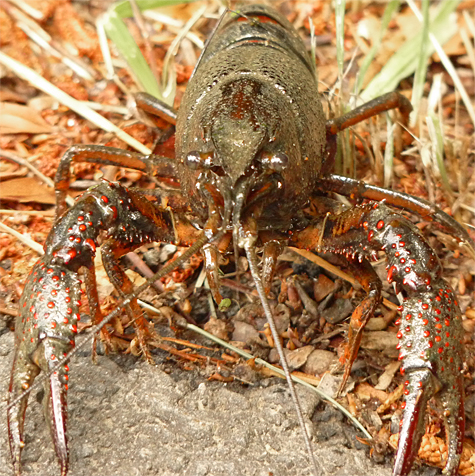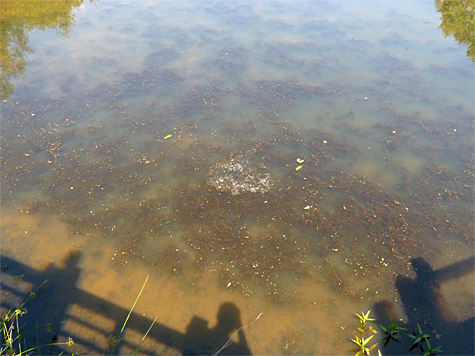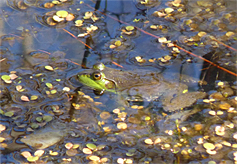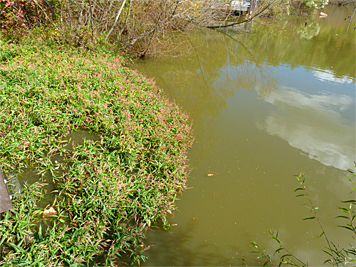Our Wetlands is Changing!
In August I wrote about a pile of crayfish hatchlings that I found on the path in Explore the Wild. I also wrote about how those crayfish are not native to our area and how they may be completely changing the Wetlands.
The crayfish that I see and capture in our Wetlands are Red Swamp Crayfish (Procambarus clarkii). I first noticed these large crayfish with the red claws a little over two years ago. Then, it was unusual to see, let alone capture, a crayfish in our little Wetland. A typical haul in a hoop net would include dragonfly and damselfly nymphs, diving or water scavenger beetles, a variety of beetle and fly larvae, scuds, freshwater clams or mussels and various other aquatic invertebrates, and perhaps a tadpole of one of the 13 species of frogs and toads that I’ve recorded here. A crayfish was unusual.

On a recent Saturday (10/15), Ranger Kristin and I were down in the Wetlands scooping through the water with a long handled net. We were after crayfish. Nearly each dip into the water with the net brought in a crayfish. I think we missed only once or twice. Several times we brought in 3, 4, or 5 crayfish. The crayfish varied in size from half inch juveniles to about two inches in length. Although we also caught many backswimmers (Notonectidae) we only caught three dragonfly nymphs and no, that’s zero, damselfly nymphs (not a good sign). And although we did catch a Water Scorpion, we caught very little of anything else.
Besides the quantity of the catch, the quality of the water itself is not as it was in the past. The turbidity of the water (water clarity) and the submergent and floating vegetation has changed considerably. A picture of the edge of the Wetlands taken in May of 2010 shows both clear water and much vegetation.

In the above photo, the water is a foot or more deep at the edge of the vegetation. The bottom is clearly visible. Currently, the bottom cannot be seen in six inches of water. The water will no doubt clear up a bit with cooler temperatures later in the season, but this summer was the worse that I’ve seen. Why is the water more turbid now than before?
Wait, before we get into the water quality, a little background info. Historically, the Red Swamp Crayfish is native to Texas, Oklahoma, Arkansas, Missouri, Illinois, Kentucky, Tennessee, Louisiana (crawdads), Mississippi, Alabama, and Florida. They are now in at least 16 other states including Hawaii. And, they can be found on nearly every continent from Asia to Europe and from Africa to South America.
These large red-clawed crustaceans were purposely introduced for human consumption as food to most locations outside of their natural range. Once there, they invaded other wetlands by either walking, swimming, being dumped by fisherman (they’re used as bait), or discarded by amateur aquaculturist who no longer desired to keep them in their aquariums as pets.
Crayfish in general eat just about everything they can get there claws on. Primarily detrivores (eaters of decaying organic matter), they will consume whatever is available, which includes plants and animals. They don’t simply browse on the plants that they eat but cut the plants off at their bases, discarding what they don’t eat (important). They consume snails, aquatic insects and their larvae, fish and tadpoles and the eggs that they came from…but you get the picture, they eat everything.
Now, back to the water quality. In a study done in Japan, “Contribution of bioturbation by the red swamp crayfish Procambarus clarkii to the recruitment of bloom-forming cyanobacteria from sediment,” Yoshimasa Yamamoto writes:
“…results of this study suggest the potential influence of crayfish-associated bioturbation on the dynamics of cyanobacteria in the Hirosawa-no- ike Pond where the recruitment of cyanobacteria from the sediment is assumed to be especially important in the formation of cyanobacterial blooms.”
In other words, the crayfish, through their daily routines of burrowing and just moving about and feeding, stir up the bottom sediment releasing bacteria which causes blooms of that bacteria, also known as blue-green algae, which would not happen if the crayfish were not present.
How does the turbidity affect the Wetlands? Besides the result of making it more difficult for herons, kingfishers, and fish eating mergansers to see their prey, the algal bloom can potentially deplete the water of its dissolved oxygen making it difficult for the prey itself to survive in the water. And, there are many organisms that share the pond that also need oxygen, like some of the macro inveterbrates and aquatic vertebrates mentioned earlier. Blue-green algae is not a good thing.

Submergent vegetation is typically rooted in the bottom of a pond or stream and grows completely below the water’s surface, it is submerged. There currently is no submergent vegetation to be seen in the Wetlands. Submergent vegetation is important to the survival of many aquatic invertebrates that use the vegetation as both food and shelter. It’s also used as food for larger animals like ducks and geese and as shelter for tadpoles and fish. The submergent vegetation is gone.
Where did the plants go?
In a study done in Kenya “Feeding of the exotic Louisiana red swamp crayfish, Procambrus clarkii (Crustacea, Decopoda), in an African tropical lake: Lake Naivasha, Kenya” the authors said:
“It is concluded that P. clarkii could well have accounted for the observed elimination of native plant species in Lake Naivasha;”
As mentioned earlier, crayfish are omnivorous, they eat it all, including plants. But instead of browsing on the plant, allowing those parts that were browsed upon to grow back, the crustaceans cut the plant off at the roots, eat what they want and discard the plant. The discarded plant may very well end up being their next meal, this time as detritus (decaying organic matter) but the damage is done, the entire plant and its use as a shelter and food for other creatures is history. It’s like cutting down the tree to get at the walnuts.
There are many other studies which attest to this crayfish’s ability to completely alter a pond or wetland. I’ve quoted but a few. Our Wetland here at the Museum of Life + Science is unquestionably different than it was just a year ago. We are catching fewer species of all aquatic life (except crayfish) in our sample nets, the submergent vegetation that used to reside in the Wetlands is gone, and the turbidity is up.
Check this link to see the clarity of the water in the fall of 2009 as a grebe swims around catching fish, tadpoles, and crayfish. Scroll down the photos. In one image, the grebe’s shadow can be seen on the bottom in about two feet of water. You’d be lucky to see it’s feet today.

I found very few Green Treefrog young in the vegetation alongside the Wetlands this summer where typically I could locate half a dozen on any given day in July or August. True, the dry summer could have had an effect on the numbers of treefrogs, but earlier in the summer there were plenty of adults out breeding.
I didn’t see any bullfrog egg masses in the water this past summer. It’s possible that I simply missed both the treefrogs and bullfrog eggs, but I usually keep an eye out for such things. Perhaps the open water situation left the eggs open to predation. Had there been any bullfrog eggs deposited this summer they would have been exposed from below.
The various species of frogs have different egg laying strategies. Some, like the bullfrog above, lay their eggs in sheets on the water’s surface. Some frogs deposit eggs in masses attached to a twig or submergent plant stem. Others drop the eggs in the leaf litter on the bottom of the pond. The water’s surface is open from below without the submergent plant cover, which also means that there are no plants in the Wetlands to lay eggs upon for those species that use that method of egg deposition, and the leaf litter has all but been eaten by the crayfish, at least in the areas of the Wetlands away from the cover of the willows. It’s not all doom and gloom though, there are still many areas among the willows and some of the emergent plants, like the rushes, where frogs can lay their eggs the way they need to.
Once these crayfish enter a wetland they’re very difficult to get rid of, if that’s what’s desired. I read one report where a pond in which the crayfish had colonized was bleached. You can search for more info about the bleaching event on the internet just by typing bleached Wisconsin crayfish. I don’t think we want to bleach our wetland.
This past summer we had a Yellow-crowned Night-heron stay with us. Yellow-crowns eat crayfish. Maybe a breeding pair or two will take up residence here at the Museum next year and work on lowering the crayfish numbers. The resident raccoons, who also eat crayfish, don’t seem to be able to keep up with the prolific decapods.
While the crayfish are here it may be a good idea to test them for retention of heavy metals and other pollutants in their muscles.
After, and if, they are cleared of any pollutants, we should set out traps, catch a mess of the little mudbugs and have a big Crawfish Boil on the Wetlands Overlook. And in Texas…
——-
Wow! Thank you. During the last 17 year Cicada emergence I found mud towers in a low-lying wet wooded area. I wondered if they might be primary-burrowing crayfish. Upon reflection, I think they were cicada towers. Nature is fascinating! Thanks, again.
What happened with the odd protrusions in Part I?
Good question, and my fault for not following up on the odd protrusions on the crayfish. They were, as suspected, water boatmen.
I wonder if the animal department, local rehabbers, Triangle Wildlife Rehabilitation Clinic, or even the NC Zoo would want a big batch of these guys for animal diets or enrichment!
Hey Kristen,
That may be something to consider, let the exhibit animals eat them. I think though, that we should find a way to test the bugs for whatever metals or toxins that they may have picked up. They’ve fed on just about everything in the Wetlands from the plants to the fish and frogs, and have stirred up the sediment, they could probably give us at least a hint as to what is in that sediment.
Thanks,
This is so interesting! Do you think it would be worth our effort to reclaim the wetland from these buggers?
I’d like to see the Wetlands the way it was before the crayfish arrived. The crayfish have apparently altered the wetlands considerably. I was down there this morning with a net and again caught more crayfish than anything else.
I do think, though, that while they’re here (the crayfish), it might be worthwhile to do a coordinated study of them, and the water that they’ve managed to change so much.
Thanks,